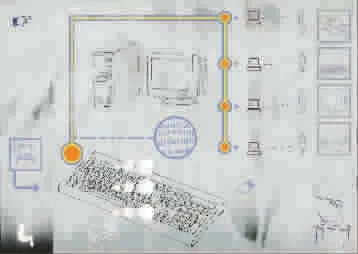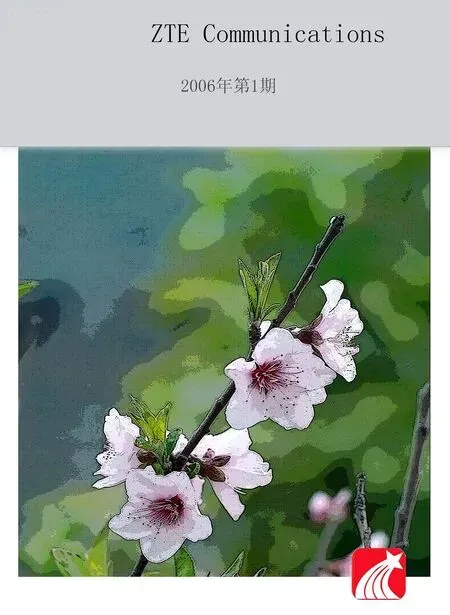Operations Support Systems Standards: Status Quo and Trends
Wang Yanchuan Kong Lingping
(China Telecom Corporation, Beijing 100032,China)
AbstractThe emerging of diversified new telecommunications technologies leads to a continuous change of telecom networks.Consequently,the operations support systems of telecommunications operators are facing structure adjustments as well as new systems construction.In this situation,new generation operations support systems standards are urgently required.Several standardization organizations have made substantial progress in the study of the new generation standards,such as ITU's study on Next Generation Network(NGN)management,TMF's on New Generation Operations Systems and Software(NGOSS)and CCSA's on network management standards.However,the existing operations support systems face the challenges of architecture improvement,change of the focus of operations support,orientation of customers'demands and technology evolution.
T he rapid development of new telecommunications technologies,such as Digital Subscriber Line Technologies(xDSL),Wireless Local Area Network(WLAN),3G mobile communication systems,Next Generation Network(NGN)and Voice over Internet Protocol(VoIP),has brought telecommunications operators with new business opportunities as wellas challenges of network reform.In the process of network reform,the Operations Support Systems(OSS)of the telecommunications operators are facing structure adjustment and construction of new systems.Anew OSS adaptable to the new network cannot be built without the guidance of related specifications and standards.Therefore,there is currently an urgent demand for next generation OSSstandards in the telecommunications industry.Under such conditions,some international standardization organizations play an active role in the related field and have promoted the rapid development of related standards.
1 ITU and Its NGN Management Standards
For a long time,the International Telecommunications Union(ITU)has been one of the main international standards study institutes.In telecommunications network management,ITU-Thas many study groups including SG4,SG2,SG6,SG9,SG12,SG13,SG15,SG16,SG17 and SG19,and SG4 is the lead one.ITU has released its famous Telecommunications Management Network(TMN)serial standards,including network management principles,high-level framework,network management functions,information modules,interfaces,and more.SG4 has made great contribution in integrated management of telecommunication networks with different technologies and of equipment from different vendors.At present,ITUhas started to change its telecom management study modes from the previous“simply network-oriented,equipment-oriented,technology-oriented and bottom-up”to“business operation-oriented and up-bottom”.
Thus,ITU has shifted one of its research weights in the field of telecommunications network management to telecommunications network operations management standards,and recently introduced a new concept of enhanced Telecom Operations Map(eTOM).Another focus in telecom network management from ITU is NGNmanagement.ITU-Thas purposely established Focus Group on Next Generation Network(FGNGN),and NGN Management Focus Group(NGNMFG)under SG4 is focused on NGN related issues.NGNMFG will follow the sequence of“high-level requirements→management requirements→management principles and architecture→protocol-independent interface specifications→protocol-dependent interface specifications”to develop NGN management standards.

At present,ITU standards in NGN management are classified under the following 4 types[1]:
(1)The standards specially developed for NGN management,such as Y.2001,Y.2011 and M.3060.M.3060 is the latest ITU-Tstandard for NGN management principles released on September 30,2005.This standard describes the requirements and fundamentalprinciples of NGN management,and elaborates on NGN management architecture from the angles of service flow,management functions,management information and physical implementation,and also on the relationship among these different types of architecture.M.3060 is one of the most fundamental and important ITU-T standards for NGNmanagement.
(2)The general telecommunications management standards that NGN management must follow such as the standards for failures,configuration,billing,performance,services and function domains.The standards include X.733.1,M.3016 serials,M.3341,M.3350 and M.3050.In addition,related standards from the Internet Engineering Task Force(IETF)and the Organization for the Advancement of Structured Information Standards(OASIS)are imported.
(3)The standards for management of functional entities of the NGN,such as the transport layer,service layer,Customer Premise Equipment(CPE)management.The standards include G.7718 and Y.1709.Most standards of this type are borrowed from available standards released by TeleManagement Forum(TMF)and the 3rd Generation Partnership Project(3GPP).
(4)Other related standards,such as IETFRFC3444(on the difference between information models and data models).In the new research period of 2005-2008,ITU also focuses the study of telecommunications network management on making standards for network equipment testing and maintenance,and on standardization of the service management layer and business management layer.
2 TMF and NGOSS
The Network Management Forum(NMF)is the predecessor of TMF.TMFwas dedicated to following the TMN framework to accomplish specifications development,concept verification and model project deployment of the telecom OSS.At present,TMFis focusing on the New Generation Operations Systems and Software(NGOSS).It not only conducts related study on Shared Information/Data(SID)models,as well as on its modulization and commercialization,but also facilitates research cooperation with software developers and integration companies in the industry.TMFis fast developing,with 450 members in more than 60 countries,including 17 members in China.
Seen from the system architecture,NGOSStries to set up a module-based distributed system,define key system services,and support dynamic services and operation management required by the information and communication industry[3].Layered abstract activities enable the system architecture to be independent of technology,giving companies freedom to choose applicable technologies and to switch to future new technologies.The main characteristic of NGOSSis taking the general principles for TMN as its guidance,and adopting software modules to establish reasonable business flow models for telecom operators.TMFformally released NGOSS 5.0 in July 2005.The core in Release 5.0 consists of 4 frameworks:
·The eTOM business process framework,with the document number GB921.
·The SID model,with the document number GB922.
·The telecom applications framework,i.e.Telecom Application Map(TAM),with the document number GB929.·The system integration framework,i.e.Technology Neutral Architecture(TNA),with the document number TMF053.
Comparing with the previously released NGOSS 4.0,NGOSS 5.0 has the following changes:
(1)eTOM is updated to Version 5.0.The main changes include updating the process decomposition in GB921D,adding a description of relationships between eTOM and ITInfrastructure Library(ITIL)in GB921V,and adding GB921N.eTOM 4.5 has previously been formally adopted as the M.3050 standard by ITU.
(2)GB929 telecom applications framework is added.It describes how to organize and divide actual OSS.It elaborates on corresponding function modules to Fulfillment,Assurance and Billing(FAB)from different layers.These layers include the service management and operations layer,resource management and operations layer,customer relationship management layer,and supplier/partner relationship management layer.
(3)Documents GB932 and GB933 are added.They compare the SID model of NGOSSwith Common Information Model(CIM)made by Distributed Management Task Force(DMTF)in the aspects of physical and logical resource models,to ensure these two information models may work together.
3 Other International Organizations'Standards
With respect to 3G networks and management,the mainstream standards are made by 3GPPand 3GPP2.In the 3GPPserial standards,12,32 and 52 serial standards made by Technical Specification Group-Service and System Aspects(TSG-SA)are the main standards related to 3G network operation.In 32.101 standard,principals and high-level requirements of telecom management are described.In the 3GPP2-released standards,the S.R0017 standard made by TSG-S(service and systems aspects)also gives a corresponding description of the high-level requirement of 3G wireless network management.
The European Telecommunications Standard Institute(ETSI)is also one of the international organizations in NGN network management.Its TISPAN WG8 focuses on the study of OSSstandards.At present,the latest editions of NGN management standards include TS188 001 and TS188 003 released in September 2005(about OSSarchitecture and requirements of NGN management),DTS 08004,DTS 08006,DTS 08007 and DTS 08008.ETSIhas played an important role in establishing the leading position of Europe in the standardization of NGN multi-service network technologies.Besides,ETSIalso studies comprehensive IPnetwork management and management across industries.
4 CCSA and Its Standards
In order to get benefit from the achievements and experience of international standardization organizations such as ITU and TMF,to promote the transformation of advanced technologicalachievements,and to provide effective guidance to the development of Chinese telecom industry,China Communications Standards Association(CCSA)was established at the end of 2002.All the big equipment vendors,operators,integration companies and research institutes in China actively support and join CCSA.CCSA has formally entered the Global Standards Collaboration(GSC)as the 10th partner.
CCSA has 9 technology committees,out of which the Network Management Technology Committee(TC7)mainly engages in the study of network management and maintenance,and is specialized in the study of ITU-TSG4.TC7 has 3 working groups,in charge of the study of standardization of wireless communication management,transmission and access network management and comprehensive management respectively.
In the aspect of wireless communication management,CCSA has made“Technical Specifications for 3G Mobile Communication Network Management”,(including the General,Interfaces,Configuration Resources Model and Performance Resources Model),“Technical Requirements of 800 MHz CDMA Digital Cellular Mobile Communication Network Management Interface”,“Serial Technical Specifications for WLAN Management”.In 2005,it completed“Serial Specifications for 3G Mobile Communication Service Commissioning”,“Serial Specifications for 3G Mobile Communication Network Testing Methods”,“Serial Specifications(Enhanced)for 3G Mobile Communication Network”,and“Alarm Correlation Analysis of Universal Mobile Telecommunications System(UMTS)and Alarm and Service Relationship Model”.
In the aspect of transmission and access network management,CCSA completed the following standards in 2005:“Specifications for Wavelength Division Multiplexing(WDM)Network Management NML-EML Interface”,“Technical Requirements of Ethernet Passive Optical Network(EPON)Management Interface”,“Technical Requirements of Digital Subscriber Line(DSL)Network Management Interface”,“Technical Requirements of Synchronous Digital Hierarchy(SDH)based Multi-Service Transport Platform(MSTP)Network Management”,and“Universal Information Model of SDHNetwork EMS-NMSInterface”.Moreover,the new research programs initiated by CCSA include“Technical Requirements of Automatic Switching Optical Network(ASON)Network Management”.
In the aspect of comprehensive management,CCSAmade the following standards in 2005:“Technical Requirements of Softswitch Network Management System Part I”,“Serial Specification for IP-based VPN Network Management”,“Serial Specifications for Technical Requirements of IPNetwork Management”,and“Technical Requirements of IPTVNetwork Management Interface”.New research projects include“Specifications for IPv6 Network Management System Functions”and“Technical Requirements of Optical Line Protection Management System”.


5 Development Trends of OSS Standards
Seen from the current development of network management standards or OSS standards,the following trends are obvious:
(1)Merge of TMN and NGOSS.TMN and NGOSSare the main network management framework systems.TMN adopts the bottom-up mode,beginning from the basic requirements of the bottom layer network and managed network elements,and evolving upwards to the upper layer networks.It emphasizes the management of professional technical networks and services.Adopting the up-bottom mode,NGOSSstarts from the business process,and evolves downwards to system distribution,integration and evolution.It emphasizes more on the end-to-end operations management support,and reflects the modern operation principle of“the customer-oriented”.The convergence of TMN and NGOSSis gradually expanding,which is evidenced by the adoption of eTOM of NGOSSby ITU.
(2)New technology network management,such as the management of NGN,IPv6 network,ASON,3G and all kinds of access networks.
(3)Customer Service Level Agreement(SLA)management,including the universal SLA template,definitions of private network SLA parameters,and more.
(4)End-to-end QoSmanagement,including the application of kinds of probes and measurement techniques in end-to-end QoSguarantee.
(5)The convergence of information models under different framework systems.In Documents GB932 and GB933 of TMF,the TMFmodel and the CIM made by DMTFare primarily mapped to ensure the two information models work together.How the TMF network management information model maps,interworks and even merges with the ITU-Tinformation model basee on Guidelines for Definition of Managed Objects(GDMO)is one of the research orientations for the future OSSstandards.
(6)Study on the interfaces of operators with customers,partners and other operators.
(7)Mapping between eTOM and ITIL
Made by the ITService Management Forum(ITSMF),ITILoffers a set of comprehensive and uniform optimal practices in the ITservice management area in order to help enterprises raise efficiency through IT.eTom and ITIL study processes in different fields,but there is much overlapping between them,such as in the FAB process of eTOM.
With the development of network technology,future telecom network equipment has become more intelligent with the application of computers,therefore,we need to introduce and benefit from computer management optimal practices such as ITIL.In Document GB921Vof NGOSS 5.0,partial mapping is made between the third layer of eTOM and the ITILevent management process.Mapping of service support and service configuration processes between eTOM and ITIL is under further study.
6 Conclusions
With the rapid development of technology and fierce operation competition,current OSSfaces challenges of system structure improvement,supporting weight shift,customer demand orientation and technology evolution.It will effectively promote the construction of OSSby fastening the release of related standards.This helps OSSadapt to the development of new telecom technologies and new characteristics of telecom operations better.

